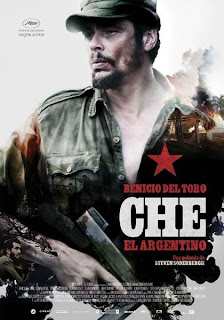Che

Knowing that the complete, four-hour plus version of Steven Soderbergh's Che was going to have a limited engagement in New York, I was annoyed to find that I missed my chance to see it at the Ziegfeld, the largest single-screen theater in Manhattan (and where I first saw Apocalypse Now almost thirty years ago). Fortunately, it is now playing for another limited engagement at the IFC theater in Greenwich Village as a roadshow production. I took the train in and settled in for a butt-numbing afternoon with a gathering of downtown hipsters.
I would be interested in hearing from those who end up seeing this as two distinct films, because I don't think it would work nearly as well. As it is, in two parts, it doesn't present a biography of Ernesto "Che" Guevara, the Argentine doctor turned Marxist revolutionary, instead it is a diptych consisting of two guerrilla campaigns--one successful, one not. For someone to see and one and not the other, or even not in succession the same day, would rob one of the full effect.
Guevara, of course, is best known today as a ubiquitous image on t-shirts. Soderbergh has not made a film delving into the man's psyche--we have no idea of his life before a meeting with Fidel Castro in Mexico in 1955--he has made a film about the nuts and bolts of revolution. Although the result is not strictly a hagiography, I'm a little disappointed that we don't see more of Guevara's warts, particularly the reign of terror he oversaw following the Cuban revolution. Therein lies the problem that keeps this film from being a true masterpiece--a character like Guevara, who has no self-doubt, does not make for a particularly compelling dramatic character. He has no inner turmoil, no sense of regret. That may make for interesting history, but not drama. We know practically nothing of his personal life. A wife in Mexico is mentioned, but when part two starts and we find that he's married a fellow guerrilla (Catalina Sandino Moreno), the first wife is never mentioned again. What made Guevara tick? You will not find out from this film. Benicio Del Toro, as Guevara, has a commanding presence and wears this film like an overcoat, but his motivations, beyond the basic desire to help the oppressed, remain hidden.
But Che has plenty to admire. The first half concerns the overthrow of Batista's Cuban government, led by Castro, and if it is to be believed from this film, went off with hardly a hitch. Castro's men marched across the island, taking the country town by town, recruiting as they went along, the peasants of the impoverished nation eager to help. Castro is played engagingly by Demian Bichir, and the other guerrillas are a classic collection of war movie types, only they are all Cubans. The part ends with a long battle in the town of Santa Clara--the fall of Havana, which happened on New Year's Eve (and is familiar to those who have seen The Godfather, Part II) is not seen, because Geuvara wasn't there.
The first part is structured as a flashback, with Guevara visiting New York to address the United Nations. He is being interviewed by a journalist (and attends a party, meeting Eugene McCarthy). The second part has no such structure--it is a straightforward rendition of Guevara's attempt to get lightning to strike twice and overthrow the military dictatorship in Bolivia.
This campaign is riddled with problems, although none of them are chalked up to Guevara (although some are resistant to him being a foreigner, a situation that pops up briefly in Cuba). The peasants never really catch on with the revolution, and this time the U.S. steps in and contributes men and material to smother the insurrection. In this half it's also far more difficult for the viewer to keep track of who's who (especially when the band is separated--Guevara comes and goes without warning).
The script, by Peter Buchman and Benjamin A. Van Der Veen, is based on Guevara's writings, and packs in a lot of information, but almost all of it is of a military nature (we do get some facts like Guevara's asthma, and it's interesting that as a doctor he continued to smoke cigars). The photography by Peter Andrews (which is a pseudonym of Soderbergh's) is a mix of styles, from the scratchy black and white of the New York sequences to the vivid colors of the Cuban and Bolivian jungles, and several scenes shot with hand-held cameras.
I would recommend any serious moviegoer attempt to see this film in its single form, failing that, to see the two films in sequence and close together. Though it has its dramatic failings, it remains an impressive achievement.


Comments
Post a Comment